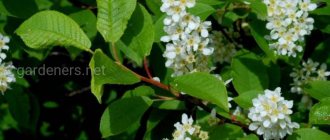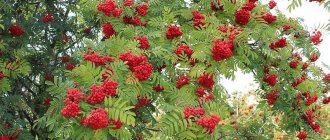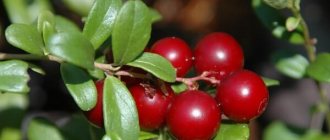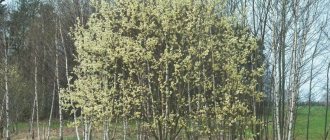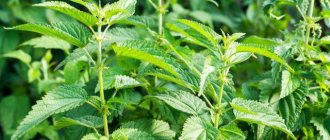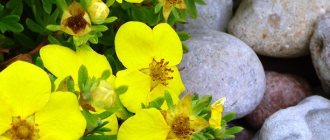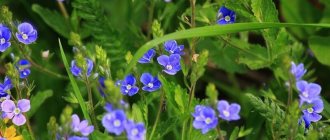Many poems and songs have been written about her. People affectionately call it the bride, emphasizing the dazzling snow-white beauty during flowering. The unforgettable aroma of flowers is carried by the wind for meters around.
Bird cherry is a tree known in all corners of our vast Motherland; in nature it grows along river banks, in parks, forests and gardens. The berries are black in color and used in cooking. Compotes, jams are made with bird cherry berries, and wine is infused.
This tree is endowed with a lot of healing properties, which are confirmed by reviews in folk and official medicine. Bird cherry bark is highly durable; in the old days it was used by coopers to make small dishes, hoops for tubs, rollers for squeezing clothes, and parts for furniture.
Bird cherry tree description
Bird cherry of the Rosaceae family, deciduous tree up to 20 m in height. It has lived in nature for more than half a century and is easy to care for. The branches are crimson, smooth. The tree trunk is up to 40 cm in diameter, the bark is dense. The leaves are rich green, numerous. In autumn the crown turns yellow, then crimson.
Flowering begins in June and lasts two weeks. The flowers are five-petaled, collected in racemes, with a strong scent. The aroma of flowers spreads over a distance of 100 m and has many volatile phytoncides. The smell of wood is so strong that there are no insects around the trees. It has a strong effect on the human sense of smell, causing headaches.
The root system is branched, with a large number of shoots. Bird cherry berries with a small seed, sweet taste with an astringent aftertaste. The berries ripen at the beginning of August.
Many people wonder – is bird cherry a shrub or a tree? From a biological point of view, a shrub is a plant, up to 6 m high, without a trunk. The tree (fruit) grows up to 20 m in height and has a trunk. The bird cherry plant is most often a tree, occasionally a shrub.
Common bird cherry or raceme
This bird cherry is also called bird cherry - it is found naturally in the forests of Eurasia. This is a tree-like plant, rarely represented by shrubs, growing up to 18 meters in height. The foliage of bird cherry is greenish in color with a hint of blue, in the lower part it is bluish. By autumn, the leaves turn yellow, carmine or purple. The tree blooms every year in mid-spring. The fruits of the tree are small, about 0.5 cm in diameter, dark in color with shine, and sweetish.
The most popular variety of bird cherry is “Colorata”. This is a shrubby plant, growing up to 5 meters in height. The leaves are lilac or reddish in spring, but turn green by June. Bird cherry inflorescences are large, pinkish, and smell aromatic like almonds. The branches and bark of the plant are purple in color. The shrub needs good lighting and high humidity, and is resistant to low temperatures. The fruits ripen at the end of summer.
Interesting varieties of common bird cherry:
- pendula – weeping crown;
- pyramidalis – crown in the form of a pyramid;
- roseiflora – pinkish flowers;
- plena – double flowers;
- leucocarpa – yellowish colored fruits;
- aucubaefolia - leaves are strewn with small yellow spots.
Types and varieties of bird cherry
Breeding new hybrid plants is possible due to the fact that the plant is easy to care for and is easily propagated by layering. There are 20 species growing in our country. Breeders have bred numerous hybrids that bear fruit. They differ in the size of the berries and the amount of harvest. Other varieties are bred for flowering.
- Dawn - early ripening, winter-hardy, yield up to 30 kg per tree;
- Late joy – with large berries up to 8 mm, juicy, without astringent effect;
- Russian terry is a winter-hardy hybrid with large flower clusters, yield up to 40 kg.
Colorata, Albert II, Wateren, Wendel are hybrid varieties bred in European selection. They are distinguished by large brushes and double flowers. The berries of hybrid species are black, large, but not edible.
Bird cherry
Prunus padus is the most common species, the bird cherry. Grows along the banks of water bodies. If conditions for development are unfavorable (cold zones, high groundwater), the tree becomes small and takes on the shape of a bush. Due to the fact that the buds swell earlier than other trees, they are often subject to freezing. Bird cherry berries can be eaten; they have a slight astringent aftertaste.
Bird cherry virginia
Padus virginiana is a tree up to 15 m growing in North America. Productivity is high, characterized by rapid ripening of edible fruits. The taste of the pulp is sour, there is no astringent effect. The Virginia variety is not pollinated by other varieties; they prefer only related trees. The tree blooms in early May, odorless. In the selection of the Virginia species, the following varieties are known: Schubert, Canada red and Shpeta.
Bird cherry maaka
Padus maackii is an Asian plant species called "bearberry". The taste of the fruit is bitter and is considered inedible. Grows up to 15 m high, trunk with dense bark. The leaves are green, turning yellow in autumn. The clusters of bird cherry inflorescences are small and the smell is weak. The most famous variety of maack is Prunus maackii Amber Beauty.
Asian bird cherry
Padus asiatica is a tree growing in Siberia and the Far East, 12 -15 m tall. During the flowering period it is covered with snow-white, fragrant flowers. Grown for landscaping. The berries are black, sweet and sour, edible.
Bird cherry Magaleb
Padus mahaleb is a European species of tree; in our country it grows in southern latitudes. Known under another name - European antipka. A tall tree with up to 4-5 trunks. It blooms with numerous white flowers with a honey scent. The berries ripen in August and are not edible.
Bird cherry finely serrated
Padus serrulate - found naturally in China, Korea, and the Far East. A huge tree more than 20 m high, with inflorescences that have two shades: pink and white. The finely serrated hybrid variety is distinguished by its crown shape. They are pyramidal, conical and weeping. Planted as ornamental trees in parks and gardens. The berries are bitter and inedible.
Bird cherry syori
Padus ssiori - grows on Sakhalin and the southern part of the Kuril Islands. Bird cherry syori is a late variety, no more than 7 m high, differs from all types in the color of the bark and branches. Blooms profusely with white flowers. The fruits are 1 cm in diameter, edible, sweet and sour.
Where does bird cherry grow?
The distribution of bird cherry is quite wide. In the world it can be found in the countries of North Africa, almost everywhere in Europe, Turkey and Transcaucasia. The plant also grows in Central and East Asia, including some provinces of China. In Russia they grow in all regions:
- everywhere in the European part;
- in the Urals;
- in the south of Western and Eastern Siberia;
- in certain regions of the Far East.
The tree grows well in moist and fertile soils close to groundwater. The culture can be found on river banks, on the edges and forest clearings.
Bird cherry is classified as a garden tree. It can often be found in summer cottages, city parks and squares. Used in landscape design: in single plantings, in the form of a hedge.
Calorie content and composition of bird cherry berries
Bird cherry fruits are a product that contains 45 kcal per 100 g. In dried berries, the calorie content increases to 100 kcal per 100 g. Nutritional value of berries: carbohydrates 10 g; There are no proteins or fats in berries; organic acids 2 g. Carbohydrates contain useful disaccharides, monosaccharides, pectin, gum. The chemical composition of the berries contains the following substances:
- retinol (vitamin A); beta-carotene (provitamin A), rutin (vitamin P);
- minerals beneficial to the body: zinc, magnesium, copper, cobalt, manganese, iron;
- natural amino acids: ascorbic, malic, citric, amygdalin (mandelic acid);
- essential resins, oils, flavonoids, tannins.
Elite garden
Landscaping | Seedlings | Flowers
- To home
- Saplings Trees
- Shrubs
- Conifers
- Landscape design
- Decorative price list
jtemplate.ru – free templates joomla
- Are you here:
- home
- Trees
- Bird cherry
| Life Form: | Tree |
| Dimensions (height), m: | 6-18 |
| Crown diameter, m: | 4-8 |
| Crown shape: | Broadly ovoid. The bark is black-brown, cracking, with an almond smell, the shoots are brown |
| Growth pattern: | Grows fast |
| Annual height gain: | 50-70 cm at a young age |
| Durability: | Up to 60 years old |
| Leaf Shape: | Elliptical, pointed up to 15 cm long and up to 7 cm wide, wrinkled on top, with an almond scent |
| Summer coloring: | Dark green above, pale green below |
| Autumn color: | Yellow |
| Flowers (color): | Up to 1.5 cm in diameter, white, fragrant, collected in racemose drooping inflorescences up to 12 cm long. Honey plant |
| Beginning and end of flowering: | In May, after the leaves bloom |
| Fruit: | The fruits are edible, spherical, up to 0.8 cm in diameter, black, shiny, ripen in July-August |
| Decorative: | Particularly beautiful during flowering and fruiting |
| Application: | Single plantings, groups, edges |
| Relation to light: | Shade-tolerant |
| Relation to moisture: | Moisture-loving |
| Relation to soil: | Prefers fertile soils |
| Frost resistance: | Frost-resistant |
The benefits of bird cherry fruits for the human body
The beneficial properties of berries have been known since ancient times. It is used to make compotes, make jam, or dried. The berries are used in cooking, making pie fillings. The gelling properties of bird cherry are used for jelly and cooking marshmallows. What are the benefits of bird cherry and what to do with the berries of the plant?
- They have an astringent property that strengthens the walls of weak intestines.
- Tannins in infusions and decoctions of bird cherry help with nausea and stomach upsets.
- Purified polysaccharide - pectin is beneficial for the digestion of food, stimulates intestinal function, and normalizes the microflora of the stomach.
- Fruit juice strengthens the immune system and improves health.
- Phytoncides contained in berries help fight microbes, viruses, and have antibacterial properties.
- An infusion from the fruits of the plant has antipyretic and antibacterial effects.
- Having a diuretic effect, they have a positive effect on kidney function.
- Decoctions of tree bark relieve inflammation, disinfecting scratches and wounds.
- 9. Normalizes the nervous system.
What plants are planted next to bird cherry
Bird cherry has no preferences regarding its “neighbors”. However, if there are other trees and shrubs nearby, you will have to especially carefully control the root growth, otherwise it will simply “strangle” other plantings. Timely preventive treatments with fungicides are no less important.
The tree forms a dense crown, so only shade-loving ground cover plants are suitable for planting in the tree trunk. But they do not always withstand the fight against bird cherry seedlings and shoots.
Medicinal properties of bird cherry
Ripe bird cherry berries are used to fight infectious diseases and contain large amounts of vitamin C. Saturating the body with vitamins promotes a speedy recovery in the fight against viral colds. The benefits of berry juice are also manifested in its antiseptic properties; bird cherry decoction will help cope with respiratory colds.
Tannins contained in the fruits of the plant have been used to treat diarrhea since ancient times. Eating a handful of dried berries will stop an upset stomach. Eating bird cherry berries is beneficial for people suffering from diabetes. A low glycemic index will not cause spikes in blood sugar and will help cleanse blood vessels of excess cholesterol.
Freshly squeezed juice of the plant is useful for healing skin damage; lotions made from a decoction of ripe bird cherry have healing properties. Drinks and decoctions from berries ease the course of illnesses for those who have diseased kidneys, arthritis, dermatitis, and rheumatism. The fruits of the plant will help regulate the female cycle and restore male potency
How to get rid of bird cherry on the site
Already in the 2-3rd season after planting, bird cherry begins to actively form basal shoots. It also reproduces by “self-sowing”: seeds from berries falling to the ground sprout.
In order to prevent the tree trunk from becoming overgrown first, and then the entire garden plot, the growth of bird cherry has to be limited. To combat unwanted plantings, two methods are used:
- Physical. Recommended, unless the issue is critical, suitable only for mature trees (minimum five years after planting). At the beginning of June, you need to cut down the bird cherry tree, leaving a trunk 1.2-1.3 m high, and remove all side shoots from it. Then, over the next few seasons, regularly get rid of emerging growth. It will take 3-4 years for the bird cherry to die - the tree gradually dries out, leaving only a “stump” that is relatively easily uprooted.
- Chemical. A simpler and faster method that allows you to get rid of unwanted bird cherry plantings during the season. In June-July, the crown of the tree, the shoots in the tree trunk and the soil itself are sprayed with a solution of a suitable chemical (“Hurricane”, “Tornado”). They begin to act almost instantly; by autumn the bird cherry dries completely, and the planting site can be cleaned.
The basal growth of bird cherry is partly a plus for the gardener, but often you have to look for ways to get rid of it
. Important! If the first method is chosen, all the cuts made are left open and are not closed with garden varnish or its analogues.
Use in folk medicine
The properties of bird cherry have been known since ancient times. In folk medicine there are recipes using the fruits of the plant.
- For diarrhea. 100 g of dried berries, pour a glass of water and boil for 15 minutes. The first dose of tincture is 150 g, then 100 g in the morning and evening for 3 days.
- For sore throat. 1 tsp Pour dried bird cherry into a thermos, pour boiling water and leave for 10 hours. Gargle with warm infusion every two hours.
- For stomach pain. 1 tbsp. mix bird cherry with 1 tbsp. blueberries, pour 2 glasses of water, boil the broth for 20 minutes. Take 2 tbsp. twice a day.
- To improve your well-being. Pour water over the fruits in a ratio of 1:20 and boil for 20 minutes. Strain, cool and take 1/2 glass in the morning and evening on an empty stomach.
When consuming fruits, preparing tinctures and decoctions, it is important to ensure that the black bird cherry seed is not damaged. The drupe of the plant contains amygdalin, which at an increased dose can cause mild stomach discomfort.
Bird cherry tea
The fruits are taken and the bird cherry seeds are removed soon after brewing, before the poisonous amygdalin is released. Drink warm as an astringent, vitamin-rich, anti-inflammatory agent. To prepare, pour 250 ml of boiling water into a tablespoon and leave the thermos for half an hour. Drink 1/3 glass 3 times before meals. Can be used by children.
To prepare cleansing tea after chemotherapy, poisoning with heavy metal salts - 1 tsp. a mixture of dry leaves and flowers is poured with 250 ml of boiling water, after 10 minutes, decant. Drink with honey.
Harm and contraindications of bird cherry
The phytoncides that the flowering tree spreads have an effect on humans. Therefore, it is not recommended to place bouquets with flowering branches at home, which cause severe headaches. The smell is contraindicated for pregnant women. All parts of the plant are beneficial to humans, but improper use or overdose provokes poisoning.
Baths and lotions with a decoction of fruits lead to dryness and flaking of the skin. Potassium contained in berries has a high diaphoretic effect. Therefore, after taking the infusion, you should not leave the house for 2 hours so as not to catch a cold.
Bird cherry seeds contain hydrocyanic acid. If you overuse parts of the plant, it will cause food poisoning and swelling of the respiratory tract.
Fruiting time and yield
Berries appear in the fifth or sixth year of life. The fruiting period occurs in July and August, i.e. approximately two months after the end of flowering. The fruits of the common bird cherry are small berries (the size of a pea). They are black, round in shape, with a slight elongation. The surface is glossy and shines in the sun.
The yield is 20–25 kg per mature tree, and with industrial cultivation – 140–150 centners per hectare. Despite the fact that flowering is stable, in some years there may be noticeably fewer fruits of common bird cherry. This is due to various reasons:
- effect of pests on flowers;
- death of part of the ovaries due to return frosts;
- Birds can peck already ripe berries.
Taste of bird cherry berries
The pulp of the fruit is quite aromatic, sweetish, and astringent. They are used for drying, freezing, making jam and other preparations. Used for cooking compotes, in tinctures, and also for baking.
Attention! Bird cherry seeds contain a small amount of hydrocyanic acid, which is a toxic substance.
When preparing preparations, it is better to remove the seeds. If you do not do this, the product will have a shelf life of no more than eight months.
Planting and caring for bird cherry
The plant is famous for its unpretentiousness and is easily propagated by rootstock. Many varieties are winter-hardy and suitable for growing in any climate zone. Planting bird cherry seedlings, at least 1 m high. Well-drained soil with no nearby deep water is suitable for planting. Further care of the tree consists of regular watering, fertilizing, pruning and weeding.
Planting and transplanting
Trees are planted in spring and autumn. This tree attracts many bees and wasps, so it is not planted near the house or recreation areas. The planting location is sunny, although it can grow in diffuse shade. We dig a hole for planting 0.5 m deep. Drainage is laid out at the bottom: broken brick, expanded clay, crushed stone. The soil is mixed with humus and dry leaves in a 1:1:1 ratio.
Then the planting sequence is as follows: straighten the roots of the seedling, place it in the middle of the hole, cover it with soil so that there is no void around the roots. Pour 10 liters of warm water. If replanting is necessary, carefully dig up the plant, trying not to damage the roots. Inspect the bird cherry seedling, remove all damaged or broken branches. The tree is transferred into a larger hole. The landing algorithm is the same.
Watering and fertilizing
Further care of the plant consists of watering and fertilizing. Young plants are watered as the soil dries to a depth of 5 cm. After watering, they are loosened to remove weeds. It is advisable to fertilize the plant in early spring. If the seedling is planted in soil mixed with organic fertilizer, it is not recommended to feed the plant for two years. In the third year after planting, the seedlings are watered with water in which complex fertilizers are mixed. Nitrogen-containing fertilizers are applied in the spring; mineral fertilizers containing phosphorus and potassium are best applied in the fall.
Pruning bird cherry
To prevent the tree from turning into an overgrown bush, a crown is formed. Pruning is carried out late in the fall, in early November, after the bird cherry leaves have fallen. The crown of a tree is formed so that the branches of the tree are located in the direction from the trunk. Broken, dry, damaged branches are cut out, as are those that are directed into the crown. Sections of branches should be covered with garden varnish to avoid infection.
Bird cherry leaves are rich in nitrogen, potassium, and contain lime. When applied to the soil, they will help improve soil structure.
Reproduction
The best method of propagation is root shoots, which grow in large quantities every year. The shoot of the plant has its own roots, which, when planted, easily take root in the soil. The favorable time for planting a rootstock is early spring or late autumn.
The plant can be propagated using cuttings. Cut from healthy branches, 20 cm long, which have 3-4 buds. You can root the cuttings by digging them into moist soil in a greenhouse or under a film. After a month, the cuttings will have roots, and the plant is ready to be planted in its main location.
Plant growers are trying to propagate bird cherry using seeds. The germination rate of the plant is not high, 20%.
With this method of planting, the maternal appearance is not preserved, the flower clusters become smaller, and the decorative effect of the plant is lost.
Diseases and pests of bird cherry
The main disease of bird cherry is fungal spores that infect the tree trunk. The intensity of the spread of the fungus affects the growth of the tree. In this case, not only the bark is affected, but also the branches and leaves of the plant. Spring treatment of the tree - painting the trunk with slaked lime, treating with a solution of copper sulfate will help prevent the spread of the disease.
Another serious danger is insect pests: mites, scale insects, aphids, weevils, leaf beetles, apple moths, gall mites, weevils, bark beetles. The damage to the leaves is visible to the naked eye: the leaves curl, turn yellow and fall off. The shoots of the tree become crooked and the plant may die. Treating tree trunk circles with a solution containing copper sulfate will help deter pests. Hunting belts and spraying with insecticidal preparations will help preserve the tree.
The bird cherry tree stands out among others with its snow-white flowers, behind which the foliage is not visible. A tree with a unique smell, familiar from childhood. The plant has been studied for a long time; its berries are used in medicine, cosmetology, and folk recipes. Many culinary recipes have been invented with bird cherry berries. The beneficial substances contained in berries benefit the human body.
How to deal with pests and diseases
The most common diseases are:
Red spotting (eg rubella). This is a fungus that appears as red spots on the leaves. To combat, use a three percent solution of Nitrofen, which must be used to treat the tree itself and the soil around it.
Powdery mildew. It is a white coating similar to a cobweb. Remove damaged leaves and spray the plant generously with fungicide.
Rot. The main cause of wood rot is tinder fungi. It is important to take appropriate measures in time. If you find a place of rotting, then you need to remove the rotted part of the bark and cover this area with a special mixture (clay with fungicide).
Cytosporosis. This disease causes branches to dry out and small bumps (fungus) to appear. Also, one of the symptoms will be red threads that come out of these formations during rain.
Bird cherry has plenty of pests and diseases, but as practice shows, many of them can be avoided or even prevented.
Having considered methods of combating common diseases, let’s move on to harmful insects. Most often, the tree is exposed to the following pests: aphids, bugs, moths, hawthorn and silkworms.
An effective way to reduce these insects to a minimum is to treat them with a special solution twice a season (60 grams of karbofos per 10 liters of water). Treat at the rate of 2 liters per tree.
Features of the use of bird cherry (video)
The collection of bird cherry flowers and foliage is carried out in May-June during the period of active flowering of the tree. These parts of the plant are dried under a canopy, in the attic (if it is well ventilated), outside - but not in direct sunlight, or in a drying cabinet. Dried flowers and foliage can only be stored for a year, until new raw materials are collected. But the berries should be picked early in the morning or late in the evening.
The berries must be fully ripe; the branches are cut with pruning shears (or a garden knife). It is advisable to lay out the fruits to dry immediately after picking - after a couple of hours, the collected berries may begin to deteriorate. The collected fruits are laid out in a thin layer on baking sheets and placed in a sunny place to dry. During drying, the fruits should not be exposed to rain. If bird cherry berries are placed in drying ovens for drying, then the temperature in them should be 45 - 60⸰C. In Rus', the berries of the plant were usually placed in a Russian oven to dry.
Dried berries are separated from the stalks and poured into glass containers or cotton bags. If dried berries are stored correctly, the fruits retain their medicinal properties for 4–5 seasons.
Habitats
Bird cherry grows mainly in the forest zone, along river valleys it penetrates into the forest-steppe and steppe zones, in the north it reaches the northern border of the forest-tundra; in the mountains it is found up to an altitude of 1500-1800 m above sea level.
Prefers moist, fertile and drained soils with close groundwater. Optimal habitats are floodplains in flat areas; in mountainous regions—the bottoms of the valleys of the largest rivers in the low-mountain zone. The densest populations of bird cherry are found in mixed thickets of bushes. Under the canopy of forests and woodlands, bird cherry forms less dense clump thickets, usually characterized by a small number of fruiting shoots and yield.
Bird cherry blossoms well almost every year, but does not bear fruit every year, since its flowers are damaged by late spring frosts, and the trees themselves are attacked by numerous pests, especially near cities and large towns. In the floodplains of large rivers, due to the later development of vegetation due to floodplain habitat conditions, it suffers less from spring frosts.
Meaning and application[edit | edit code ]
Bird cherry fruits were used by Stone Age man, as evidenced by the results of archaeological excavations.
Bird cherry is grown in gardens and parks as an ornamental plant; forms with weeping branches, double flowers and multi-colored leaves are especially impressive.
In cultivation, the common bird cherry with black, astringent, as if lacquered fruits, and the American species - Virginia bird cherry ( Padus virginiana)
) with red fruits and late bird cherry (
Padus serotina
). More than 15 varieties of Virginia bird cherry for food use have been obtained in the USA and Canada. New varieties of bird cherry have larger and less tart fruits, with a peculiar piquant taste.
A hybrid of bird cherry and cherry, Cerapadus 1, bred by Ivan Michurin, which has bitter fruits, is used in breeding work. With the participation of this plant and the Maak bird cherry, such cherry varieties as 'Vozrozhdenie', 'Novella', 'Olympus', 'In Memory of Shcherbakov', 'Rusinka', 'Feya', 'Kharitonovskaya' and others were obtained. Some bird cherry varieties are included in the State Register of Breeding Achievements of the Russian Federation.
Bird cherry bark can be used to dye fabrics and leathers in green and red-brown tones [4], the fruits give a dark red tint.
Fine-grained, hard and elastic wood of a brownish-yellow color is used for crafts.
The essential oil contained in the leaves was used in the past to flavor perfumes. Sometimes in the distillery industry fruits were used for bitters, and much less often, flowers [4].
Use in cooking [edit | edit code]
Bird cherry is not only decorative, but also known as a fruit crop. Ripe fruits are eaten fresh, ground with sugar, and used to prepare liqueurs, tinctures and soft drinks. Their juice is used to color confectionery products and wines.
Ground dried bird cherry fruits (flour) are a filling for pies, cheesecakes, jelly is made from it, and sometimes brewed as a tea substitute. In some areas, powder from dried bird cherry fruits is added to rye and wheat flour, which gives the bread an almond aroma. The powder is also used in the manufacture of gingerbread and cakes [5] [6].
Collection, preparation and storage of medicinal raw materials
For medicinal purposes, intact and ripened, black-colored and juicy berries are collected, which are cleaned of impurities, as well as bark, foliage and flowers. The fruits are harvested as they ripen, from July to September, and the flowers – around May. The bark is harvested in early spring. Drying is best done in special dryers, at a temperature range of 40-50°C, with periodic stirring.
Properly dried plant materials can be stored in cardboard boxes, paper or fabric bags, inside a dry and well-ventilated area. The shelf life of the berries is two years, and dried flowers are stored for no more than a year. Dry bird cherry bark can be stored in proper conditions for no more than five years.
Bird cherry in landscape design
Olga Nikitina
In former times, bird cherry was an indispensable attribute of Russian gardens; it was praised as an elegant tree with an openwork crown, with snow-white clusters of inflorescences and an intoxicating aroma, and was valued for its medicinal tart berries. Nowadays, ordinary bird cherry is no longer in fashion. Due to its lush crown, the tree takes up too much space in the garden; moreover, it has become familiar, has become familiar and is no longer perceived as a miracle.
However, romantics and lovers of natural beauty still freeze with delight at the sight of a flirtatious beauty dressed in a dress made of white flowers. Specially bred varieties of bird cherry are popular, characterized by abundant and long-lasting flowering, large inflorescences, and unusual coloring of flowers and leaves.
Landing place
You can plant bird cherry in any corner of the garden. It is good near the house, traditionally grows in places for secluded recreation; its spreading and dense crown will successfully cover an unaesthetic building or a rickety fence. The sight of a blooming bird cherry is a magnificent sight, so it will not get lost even in the most remote place.
This tree is often used to decorate forest areas, where it is planted in the undergrowth, grouped in forest edges, and grown near water. Bird cherry is very appropriate when creating a garden of the traditional Russian style in combination with birch, rowan, fruit trees, serviceberry, viburnum, rose hips, lilac and mock orange.
Bird cherry looks beautiful in an open place; here the lush and spreading crown looks most advantageous. For a small area, one tree is enough, then all its beauty will be revealed against the backdrop of a well-groomed lawn. The openwork clean groups of bird cherry trees are charming; some species are suitable for alley plantings.
Companion plants
In mixed group plantings, this tree goes well with many species, although it grows strongly with age, casting a vast shadow. During its flowering period, bird cherry looks like the undisputed dominant of the group, covered with the foam of snow-white inflorescences emitting an intoxicating aroma. As it fades, it becomes a calm green background for other plants.
When selecting companions for bird cherry, preference should be given to deciduous and ornamental plants with spectacular color or leaf shape, as well as trees and shrubs that bloom at other times.
Depending on the desired decorative effect, bird cherry can be formed either on a trunk or in the form of a bush. Bird cherry's hardiness and ability to withstand pruning allow it to be used to create tall green walls and shaped hedges. Since the plant is quite light-loving, the lower part of the hedge becomes bare over time. To avoid a decrease in decorative value, it is recommended to cover exposed trunks with a layer of hedges made of bushes.
Bird cherry berries
Bird cherry berries, with a large stone and almost no pulp, are of little interest to gourmets, but are extremely attractive to birds. So, having planted bird cherry in your garden, you can be sure that bird trills will certainly sound here.
Those who want to plant bird cherry not only as an ornamental, but also as a food crop, should pay attention to large-fruited varieties. Modern cultivated varieties have rather large berries, with a more delicate taste, which has more viscosity than astringency, and up to 20 kg of harvest can be harvested from one tree.
Depending on the desired decorative effect, bird cherry can be formed either on a trunk or in the form of a bush.
Growing conditions
Bird cherry is very unpretentious, and growing it does not cause much trouble. This crop tolerates shading, is undemanding to the amount of moisture and soil fertility, tolerates urban conditions well, and is very winter-hardy. A well-developed root system allows it to withstand both drought and temporary waterlogging. The leaves, flowers and fruits of bird cherry contain benzoaldehyde, which makes them phytoncidic. The plant secretes phytoncides that kill pathogenic bacteria, which is why bird cherry is little damaged by diseases and pests and even purifies the air around it.
Types and varieties
The most common bird cherry is common, or bird cherry. It blooms early, immediately after the first leaves appear, and therefore looks most impressive. Ch. vulgare has several attractive ornamental varieties that are in demand in landscaping.
'Watereri' – English variety of black cherry. It is distinguished by multi-flowered inflorescences up to 18–20 cm long, which usually do not droop and are located almost horizontally.
'Plena' has large semi-double flowers. Flowering is not as abundant as that of simple varieties, but longer. The greatest value is the flowers themselves, which look like small roses, and therefore to plant this tree you need to choose a place where you can see such beauty.
'Colorata' is one of the most interesting and spectacular varieties of bird cherry, selected in Sweden. The bark and shoots are purple or dark purple; The leaves are bright purple when they bloom, becoming dark green with purple veins in summer. The buds are red, the blossoming flowers are pink, the autumn color of the leaves is pink-red, the fruits are dark red. The later developed variety 'Purple Queen' is more intensely coloured.
Black virginiana has smaller flowers, but they are located much more densely in the racemes. Flowering occurs two weeks later, after the leaves have fully bloomed, which greatly reduces the decorative effect. The most interesting are the red-leaved varieties of this bird cherry:
'Sсhubert' is an American variety with decorative leaf color, green when blooming, then darkening to brownish-burgundy.
'Canada Red' are also green when blooming, later turning burgundy.
Virginia bird cherry easily crosses with black cherry, producing hybrids with intermediate characteristics.
'Siberian Beauty' is a domestic variety bred from crossing the common cherry with the 'Sсhubert' of virginian cherry. Young leaves are green, then the upper side of the leaf blade becomes dark purple in color, and the lower side becomes light purple. The play of colors observed on a windy day looks very impressive and unusual.
Other species are also in demand in landscaping, such as bird cherry Maka, late, and syori.
Landing (step by step instructions)
Bird cherry is not a fan of change, so experienced gardeners immediately plant it in a permanent place.
Planting bird cherry occurs as follows:
First, a round hole is dug. It must correspond to the size of the root system and be spacious, because At first, the roots will grow very strongly and quickly.
Before planting, the seedling is brought into proper shape:
- Too long roots are shortened, defective ones are removed;
- Branches are trimmed to 60 cm;
- Some of the shoots are removed, leaving only 2-3 of the best shoots.
Humus and other nutrients are poured into the bottom of the hole, which will help the roots quickly absorb all the missing nutrients.
Important! Overloading the soil with organic matter will have the opposite effect - a high concentration of nitrogen will negatively affect the plant.
The seedling is placed in the hole, the roots are straightened so that air can penetrate inside, after which they are sprinkled with earth and the soil is compacted. When the tree is planted, it is necessary to water it and mulch the ground with peat.
